Land Management and Rural Development in Northwest China
Abstract
:1. Introduction
2. Overview of Study Areas
3. Data Sources and Research Methods
3.1. Data Sources
3.2. Research Methodology
3.2.1. Construction of a Rural Multifunctionality Evaluation Index System
3.2.2. Model of Rural Multi-Functionality Index
- 1.
- Standardization of indicators and calculation of weights
- 2.
- Calculation of the Comprehensive Index of Rural Multifunctionality
3.2.3. Rural Multifunctional Trade-Offs/Synergy Analysis Approach
- 1.
- Analysis of trade-offs
- 2.
- Determination of Production-Possibility Frontiers
- 3.
- Calculation of the trade-off intensity index
3.2.4. Rural Multifunctional Disorder Diagnostic Model
4. Analysis of Results
4.1. Evaluation of the Spatial Differentiation of Rural Multifunctionality
4.2. The Measurement of Rural Multi-Functional Trade-Offs/Synergy
4.2.1. Rank Correlation of Multiple Rural Functions
4.2.2. Quantification of Rural Multi-Functional Trade-Offs
4.3. Classification of Village Types under the Trade-Off of Rural Multi-Functions
4.4. Diagnosis of Dysfunction in Different Rural Development Zones
5. Discussion and Conclusions
5.1. Discussion
- (1)
- Comprehensive upgrading village. This is a weak trade-off area between the living guarantee/economic development functions and the ecological environment. In the future, we should focus on toilet renovation, garbage and sewage treatment, and village appearance improvement as well as improving infrastructure such as roads, water supply, and basic public services such as education and medical care. We should comprehensively promote high-quality special agricultural products according to local conditions, create regional brands of agricultural products, and improve the quality of agricultural products. In addition, the government should further develop product sales and related markets through self-media methods such as e-commerce platforms and live broadcasts. We also need to pay attention to and protect the ecological environment and revitalize natural resources such as forests and grasslands through the Ant Forest project and developing eco-tourism and other industries. The government should implement a strict ecological protection system, strengthen the monitoring of pollution by enterprises and the loss of species diversity in a given area, and coordinate and control the ecological quality of the water space. In addition, the government should use the transformation of rural house foundations as part of improving rural living conditions, further speeding up construction upgrades to improve the living environment of farmers, as well as increase space utilization.
- (2)
- Simultaneous optimization of villages. The district has a high degree of trade-off among the living guarantee, economic development, and ecological background functions. The government should fully consider the variability of social relations, build and strengthen grass-roots organizations, improve the rural governance system led by village party organizations with the participation of multiple parties, and pay attention to training local talents in the countryside. The government should increase the financial support for and investments in land utilization, agriculture, and forestry and public services such as education and medical care including elder care and enhance the value of both agricultural and nonagricultural production. In addition, the government should improve industrial zones and related facilities, raise the entry threshold of rural industries, avoid industrial homogenization, and form core competitiveness in the market. The government should improve the supporting infrastructure in poor areas, effectively cover areas with public service resources, and improve the ability to build and share public services together. The government should continue to improve the rural living environment, achieve green development, reduce the application of pesticides and fertilizers through standardized adjustment, and investigate and rectify rural non-point source pollution. In addition, we must improve the rural land resources across the whole area, strictly control the loss of rural ecological space, maintain the stability of ecological space, and build an environment-friendly countryside from a high starting point.
- (3)
- Focused development countryside. The trade-off between the functions of the villages in this area is dramatic. We should mobilize rural development enthusiasm, cultivate new rural business, adopt suggestions for residents’ living needs, develop multiple functions such as recreation and leisure and cultural experience, adjust and optimize internal space; reclaim and re-green long-idle residential foundations and revitalize other idle resources, enhance rural production and living functions, and promote new vitality for industrial development. The government should strengthen the villages and market towns with industrial clustering and population inflow. We should conduct appropriate advance planning, increase construction investment, and improve the population and economic carrying capacity. Through village development, we should mobilize the enthusiasm of village collectives and villagers for development.
5.2. Highlights and Recommendations
5.3. Conclusions
- (1)
- In the rural multifunctional space in Yongchang County, the function patterns of living guarantee, agricultural production, and ecological environment converge. The function patterns of living guarantee and ecological environment are the closest. Both are better in the central and western regions than that in the eastern regions. The agricultural production function shows significant regional differences. The agricultural production function in the eastern region is generally better than that in other regions. The economic development function has low similarity with other function patterns. The function index of townships close to the outer edge is higher than that in other regions. The comprehensive functions in the countryside are better in the western, eastern, and northern townships of the county in terms of agriculture and industry. The function index shows a distribution pattern of high in the north and low in the south.
- (2)
- The trade-off and synergy relationships between rural functions in Yongchang County are significant. The trade-off and synergy PPF curves show that the overall trade-off between the living guarantee function and the ecological background function will be intensified with the sustainable development of the ecological background function. The trade-off between the economic development function and the ecological background function shows that with the continuous development of the ecological background function, the trade-off relationship between the two weakens. The synergistic effect between the living guarantee/ecological background function and the agricultural development function gradually weakened with the input of the agricultural development function.
- (3)
- The 112 administrative villages in Yongchang County are divided into three types of villages: comprehensive upgrading, synchronous optimization, and key development based on the trade-off intensity index. In 2020, villages in Yongchang County were mainly the comprehensive upgrading and synchronous optimization types, reaching 55 and 43 administrative villages, respectively, and accounting for 86.73% of all evaluated villages. The number of key development type was relatively small at 15, accounting for 13.27% of all evaluated villages.
Author Contributions
Funding
Informed Consent Statement
Data Availability Statement
Acknowledgments
Conflicts of Interest
References
- Hu, X.L.; Li, H.B.; Zhang, X.L.; Yuan, Y. On the re-cognition of rural definitions. Acta Geogr. Sin. 2020, 75, 398–409. [Google Scholar]
- Zhou, S.Y. Four layers in one: The way to excavate the traditional rural locality. Tour. Trib. 2017, 32, 6–7. [Google Scholar]
- Xu, K.; Fang, Y.G. Rural Multi-Function Evaluation and Evolution Characteristics in Liaoning Province. Econ. Geogr. 2021, 41, 147–157. [Google Scholar] [CrossRef]
- Woods, M. Rural Geography; SAGE Publications: London, UK, 2005. [Google Scholar]
- Van HuylenBroek, G.; Durand, G. New opportunities for noncompetitive agriculture. In Multifunctional Agriculture: A New Paradigm for European Agriculture and Rural Development; Ashgate Publishing: Aldershot, UK, 2003; pp. 169–188. [Google Scholar]
- Hong, H.K.; Liao, H.P.; Li, T. Analysis of spatio-temporal patterns of rural space function based on entropy value method and Dagum Gini coef-ficient. Trans. CSAE 2016, 32, 240–248. [Google Scholar]
- Liu, Y.S.; Liu, Y.; Chen, Y.F. Territorial Multi-functionality Evaluation and Decision-making Mechanism at County Scale in China. Acta Geogr. Sin. 2011, 66, 1379–1389. [Google Scholar]
- Wiggering, H.; Dalchowa, C.; Glemnitz, M.; Helming, K.; Müller, K.; Schultz, A.; Stachow, U.; Zander, P. Indicators for multifunctional land use-Linking socio-economio requirements with landscape potentials. Ecol. Indic. 2006, 6, 238–249. [Google Scholar] [CrossRef]
- Ding, S.B. Some basic theoretical issues faced with plan of essential function region system. Sci. Geogr. Sin. 2009, 29, 587–592. [Google Scholar]
- Peter, K.; Annandale, D.; Bailey, J. Integrated economic and environmental planning in Asia: A review of progress and proposals for policy reform. Progr. Plann. 2003, 59, 233–315. [Google Scholar]
- Liu, Y.; Liu, Y.S. Progress and Prospect in the Study of Rural Region Multifunctions. China Popul. Resour. Environ. 2012, 22, 164–169. [Google Scholar]
- Li, B.H.; Zhou, X.; Liu, P.L.; Chen, C.; Liu, Y.M. Function Transformation and Spatial Reconstructuring of Zhangguying Village in Urbanization. Sci. Geogr. Sin. 2018, 38, 1310–1318. [Google Scholar] [CrossRef]
- Marsden, T. Rural Geography Trend Report: The Social and Political Bases of Rural Restructuring. Prog. Hum. Geogr. 1996, 20, 246–258. [Google Scholar] [CrossRef]
- Appendini, K. Reconstructing the Maize Market in Rural Mexico. J. Agrar. Chang. 2014, 14, 1–25. [Google Scholar] [CrossRef]
- Prothmann, S. Migration, masculinity and social class: Insights from pikine, senegal. Int. Migr. 2018, 56. [Google Scholar] [CrossRef]
- Tang, L.N.; Liu, Y.; Pan, Y.C.; Ren, Y.M. Evaluation and Zoning of Rural Regional Multifunction Based on BP Model and Ward Method: A Case in the Pinggu District of Beijing City. Sci. Geogr. Sin. 2016, 36, 1514–1521. [Google Scholar] [CrossRef]
- Zhu, Y.; Yang, X.Z.; Yang, Z.; Zhen, Y.G.; Yang, W.M.; Zhen, H.Y. Evolution characteristics and mechanism of rural multifunctionality in south Anhui tourism area based on major function-oriented zones. Sci. Geogr. Sin. 2021, 41, 815–823. [Google Scholar] [CrossRef]
- Xiao, L.S.; Yu, Z.W.; Ye, H.; Zhang, G.Q. The research of coupling rural development and economy cluster in Fujian Province. Acta Geogr. Sin. 2015, 70, 615–624. [Google Scholar]
- He, Y.H.; Fan, S.G.; Zhou, G.H.; Tang, C.L.; Peng, P. Evaluation of rural transformation development in Hunan Province based on major function oriented zoning. Prog. Geogr. 2018, 37, 667–676. [Google Scholar]
- Fu, C. The Evaluation of Rural Territorial Functions: A Case Study of henan, China. J. Resour. Ecol. 2017, 8, 242–250. [Google Scholar]
- Zhang, B.T.; Min, Q.W.; Jiao, W.J.; He, S.Y.; Liu, M.C.; Yang, L. Research progress and perspective on ecosystem services trade-offs. Acta Ecol. Sin. 2021, 41, 5517–5532. [Google Scholar]
- Liang, C.; Zeng, J. Three-dimensional dynamic identification and spatial evolution mechanism of urban-rural fringe: A case study of Xiamen. Sci. Geogr. Sin. 2021, 40, 1404–1420. [Google Scholar]
- Liu, H.C.; Ren, C.Y.; Wang, Z.M.; Zhang, B. Dynamics of Ecosystem Service Functions and their Trade off and Synergetic Relationships in Great Xing’an Mountains Ecological Function Zone. J. Ecol. Rural. Environ. 2021, 38, 587–598. [Google Scholar] [CrossRef]
- Niu, L.N.; Shao, Q.Q.; Ning, J.; Huang, H.B. Ecological changes and the tradeoff and synergy of ecosystem services in western China. Acta Geogr. Sin. 2022, 77, 182–195. [Google Scholar] [CrossRef]
- Wang, J.N.; Chen, H.; Shi, Q.Q.; Liu, D.; Liang, X.Y. Research on spattal-temporal differentiation and influencing factors of land use multifunctional areas of Shaanxi province. Chin. J. Agric. Resour. Reg. Plan. 2019, 40, 101–108.11. [Google Scholar]
- Zhang, Y.Y.; Tang, L.N.; Liu, Y. Rural Function Zoning and Approaches for Rural Revitalization in the Beijing-Tianjin-Hebei Region. Econ. Geogr. 2020, 40, 160–167. [Google Scholar] [CrossRef]
- Chen, A.; Li, J.J.; Zhang, M.S.; Zhang, H.; Bian, L.J.; Li, W.T.; Xu, W.L. Research for Change of Ecosystem Service and the Tradeoff-Synergy Relation of the YLN Basin in the Tibet Autonomous Region. Res. Soil Water Conserv. 2022, 29, 313–319+329+2. [Google Scholar] [CrossRef]
- Yao, L.; Liu, Y.T. Rural Development Types in Peri-Urban Areas Based on Cluster Analysis: A Case Study of Conghua, Guangzhou. Trop. Geogr. 2015, 35, 427–436. [Google Scholar]
- An, Y.; Zhou, G.H.; He, Y.H.; Mao, K.B.; Tan, X.L. Research on the functional zoning and regulation of rural areas based on the production-life-ecological function perspective: A case study of Changsha-Zhuzhou-Xiangtan area. Sci. Geogr. Sin. 2018, 37, 695–703. [Google Scholar] [CrossRef]
- Xie, G.D.; Zhen, L.; Zhang, C.X.; Deng, X.Z.; Koenig, H.; Tscherning, K.; Helming, K. Assessing the multifunctionalities of land use in China. J. Resour. Ecol. 2010, 1, 311–318. [Google Scholar]
- Ran, N.; Jin, X.B.; Fan, Y.T.; Xiang, X.M.; Liu, J.; Zhou, Y.K.; Shen, C.Z. Study on the method of “three lines” delimitation based on the identification and coordination of land use conflict: A case study of Jintan district of Changzhou city. Resour. Sci. 2018, 40, 284–298.1. [Google Scholar]
- Lu, L.G.; Zhou, S.L.; Zhou, B.B.; Dai, L.; Chang, T.; Bao, G.Y.; Zhou, H.; Li, Z. Study on land use transformation and its eco-envi-ronmental response in the process of regional development: A case study of Jiangsu province. Sci. Gieograph. Sin. 2013, 33, 1442–1449. [Google Scholar]
- Liu, J.L.; Liu, Y.S.; LI, Y.R. Classification evaluation and spatial-temporal analysis of “Production-Living-Ecological” spaces in China. Acta Gieograph. Sin. 2017, 72, 1290–1304. [Google Scholar]
- Liu, Y.; Jiang, Z.; Wang, H.S. Spatial differentiation of agricultural regional function in Beijing and its influencing factors. J. Nat. Resour. 2020, 35, 2444–2459. [Google Scholar] [CrossRef]
- Tan, X.L.; An, Y.; Su, Y.; Zhou, G.H.; He, Y.H. Spatio-temporal dynamics of agricultural function in Changsha-Zhuzhou-Xiangtan urban ag-glomerations. Sci. Geogr. Sin. 2018, 38, 708–716. [Google Scholar]
- Xu, L.; Dong, J.; Chen, E. Coordination characteristics of land and space utilization of urban agglomeration in the middle reaches of the Yangtze River based on the function of “production-living-ecological”. Soil Water Conserv. Res. 2018, 25, 257–263. [Google Scholar]
- Wang, M.; Zhou, Z.X.; Feng, H.J. Coordinated development of urban agricultural multi-functionality of Xi’an metropolitan zone. Arid. Land Geogr. 2015, 38, 858–866. [Google Scholar]
- Li, Y.; Beeton, R.J.S.; Sigler, T.; Halog, A. Modelling the transition toward urban sustainability: A case study of the industrial city of Jinchang, China. J. Clean. Prod. 2016, 134, 22–30. [Google Scholar] [CrossRef]
- Ma, L.B.; Dou, H.J.; Wu, S.S.; Shi, Z.H.; Li, Z.Y. Rural development pressure and “three-stay” response: A case of Jinchang City in the Hexi Corridor, China. J. Rural. Stud. 2022, 91, 34–46. [Google Scholar] [CrossRef]
- Li, T.S.; Chen, X.Y.; Rui, Y.; Yang, K. Strategy and Path of Cooperative Promotion of Ecological Protection and High-quality Development in Northwest China. Econ. Geogr. 2021, 41, 154–164. [Google Scholar]
- Li, Y.; Beeton, R.J.S.; Anthony, H.; Sigler, T. Evaluating urban sustainability potential based on material flow analysis of inputs and outputs: A case study in Jinchang City, China. Resour. Conserv. Recycl. 2016, 110, 89–98. [Google Scholar] [CrossRef]
- Wu, L.; Huo, L. The Resurch of Relationship Between Node Cities in Silk Road Economic Zone. J. Northwest Univ. (Philos. Soc. Sci. Ed.) 2015, 45, 111–118. [Google Scholar]
- He, X.N.; Da, X.J.; Tan, Z. Study on the current situation of village layout in Yongchang County. Gansu Sci. Technol. 2015, 31, 1–4, 140. [Google Scholar]
- Tang, Y.F.; Zang, D.W.; Qiao, D.H.; Li, H.X.; Gao, J. The comprehensive evaluation on agricultural modernization of cities in Gansu province. Chin. J. Agric. Resour. Reg. Plan. 2020, 41, 198–206. [Google Scholar]
- Wang, N.; Du, Y.Y.; Lliang, F.Y.; Wang, H.M.; Yi, J.W. The spatiotemporal response of China’s vegetation greenness to human socio-economic activities. J. Environ. Manag. 2022, 305, 114304. [Google Scholar] [CrossRef] [PubMed]
- Wang, Z.Y.; Deng, W.; Zhang, S.Y.; Zhang, H. Correlation analysis of land use multi-functionalization and transitional geo-space in mountainous areas: Taking Changning County as an example. Sci. Geogr. Sin. 2022, 42, 1091–1101. [Google Scholar]
- Qu, Y.B.; Jiang, G.H.; Zhao, Q.L.; Ma, W.Q.; Zhang, R.J.; Yang, Y.T. Geographic identification, spatial differentiation, and formation mechanism of multifunction of rural settlements: A case study of 804 typical villages in Shandong Province. China J. Clean. Prod. 2017, 166, 1202–1215. [Google Scholar] [CrossRef]
- Zhao, Q.L.; Jiang, G.H.; Yang, Y.T.; Tian, Y.Y.; Fan, L.H.; Zhou, T.; Tian, Y.Y. Multifunction change of rural housing land in metropolitan suburbs from the perspective of farmer households’ land-use behavior. Land Use Policy 2022, 119, 106206. [Google Scholar] [CrossRef]
- Hong, S.Q.; Li, J.F. The Spatial Pattern and Formation Mechanism of Rural Area Function in Anhui Province. J. Anhui Agric. Sci. 2021, 49, 216–221. [Google Scholar]
- Yang, R.; Zhang, J.; Chen, Y.C. Differentiation and dynamic mechanism of rural devel opment in metropolitan fringe based on the functional perspective in Guangzhou City. Sci. Geogr. Sin. 2021, 41, 232–242. [Google Scholar] [CrossRef]
- He, Y.Z.; Wang, C. Evaluation and Pattern Optimization of Rural Production Space System Function: A Case Study of Banan District, Chongqing Municipality. Econ. Geogr. 2019, 39, 162–171. [Google Scholar]
- Zou, L.L.; Liu, Y.S.; Yang, J.X.; Yang, S.F.; Wang, Y.S.; Zhi, C.; Hu, X.D. Quantitative identification and spatial analysis of land use ecological-production-living functions in rural areas on China's southeast coast. Habitat Int. 2020, 100, 102182. [Google Scholar] [CrossRef]
- Wang, G.Y.; Zhao, Z.Q.; Zhu, P.T.; Li, Y.F.; Su, Z.J.; Liu, F. Regional differences and types of rural functions in the Yangtze River Economic Belt. Prog. Geogr. 2019, 38, 1854–1864. [Google Scholar] [CrossRef]
- Liu, Y.S.; Long, H.L.; Chen, Y.F.; Wang, J.Y.; Li, Y.R.; Li, Y.H.; Yang, Y.Y.; Zhou, Y. Progress of research on urban-rural transformation and rural development in China in the past decade and future prospects. J. Geogr. Sci. 2016, 26, 1117–1132. [Google Scholar] [CrossRef]
- Zang, Y.; Liu, Y. Study on the asset value accounting og cultivated land resource from the rural multi-funcional perspective. Chin. J. Agric. Resour. Reg. Plan. 2022, 43, 129–138. [Google Scholar]
- Li, G.Y.; Jiang, C.H.; Du, J.; Jia, Y.P.; Bai, J. Spatial differentiation characteristics of internal ecological land structure in rural settlements and its response to natural and socio-economic conditions in the Central Plains, China. Sci. Total Environ. 2020, 709, 135932. [Google Scholar] [CrossRef]
- Tang, X.M.; Hao, X.Y.; Liu, Y.; Pan, Y.C.; Li, H. Driving factors and spatial heterogeneity analysis of ecosystem services value. Trans. Chin. Soc. Agric. Mach. 2016, 47, 336–342. [Google Scholar]
- Tan, X.L.; Yu, S.Y.; Chen, W.L.; Ouyang, Q.L.; He, Y.H.; Zhou, G.H. Evaluation of Rural Function and Spatial Division in Chang-Zhu-Tan Urban Agglomerations. Sci. Geogr. Sin. 2017, 37, 1203–1210. [Google Scholar] [CrossRef]
- Woods, M. Rural geography: Blurring boundaries and making connections. Prog. Hum. Geogr. 2009, 33, 849–858. [Google Scholar] [CrossRef]
- Bennett, E.M.; Peterson, G.D.; Gordon, L.J. Understanding relationships among multiple ecosystem services. Ecol. Lett. 2009, 12, 1394–1404. [Google Scholar] [CrossRef]
- Dai, E.F.; Wang, X.L.; Zhu, J.J.; Zhao, D.S. Methods, tools and research framework of ecosy stem service trade-offs. Geogr. Res. 2016, 35, 1005–1016. [Google Scholar] [CrossRef]
- Liu, Y.; Gao, Y.B.; Pan, Y.C.; Tang, L.N.; Tu, M.G. Spatial differentiation characteristics and trade-off or synergy relationships of rural multi-functions based on multi-source data. Sci. Geogr. Sin. 2021, 40, 2036–2050. [Google Scholar]
- Yang, W.; Jin, Y.W.; Sun, L.X.; Sun, T.; Shao, D.D. Determining the intensity of the trade-offs among ecosystem services based on production-possibility frontiers:Model development and a case study. J. Nat. Resour. 2019, 34, 2516–2528. [Google Scholar]
- Qu, Y.B.; Zhang, Y.; Li, H.Y.; Gao, Y. Evaluation of construction land intensive use and obstadle control based on Five-Variables Collaborati on Model. Resour. Sci. 2017, 39, 1013–1025. [Google Scholar]
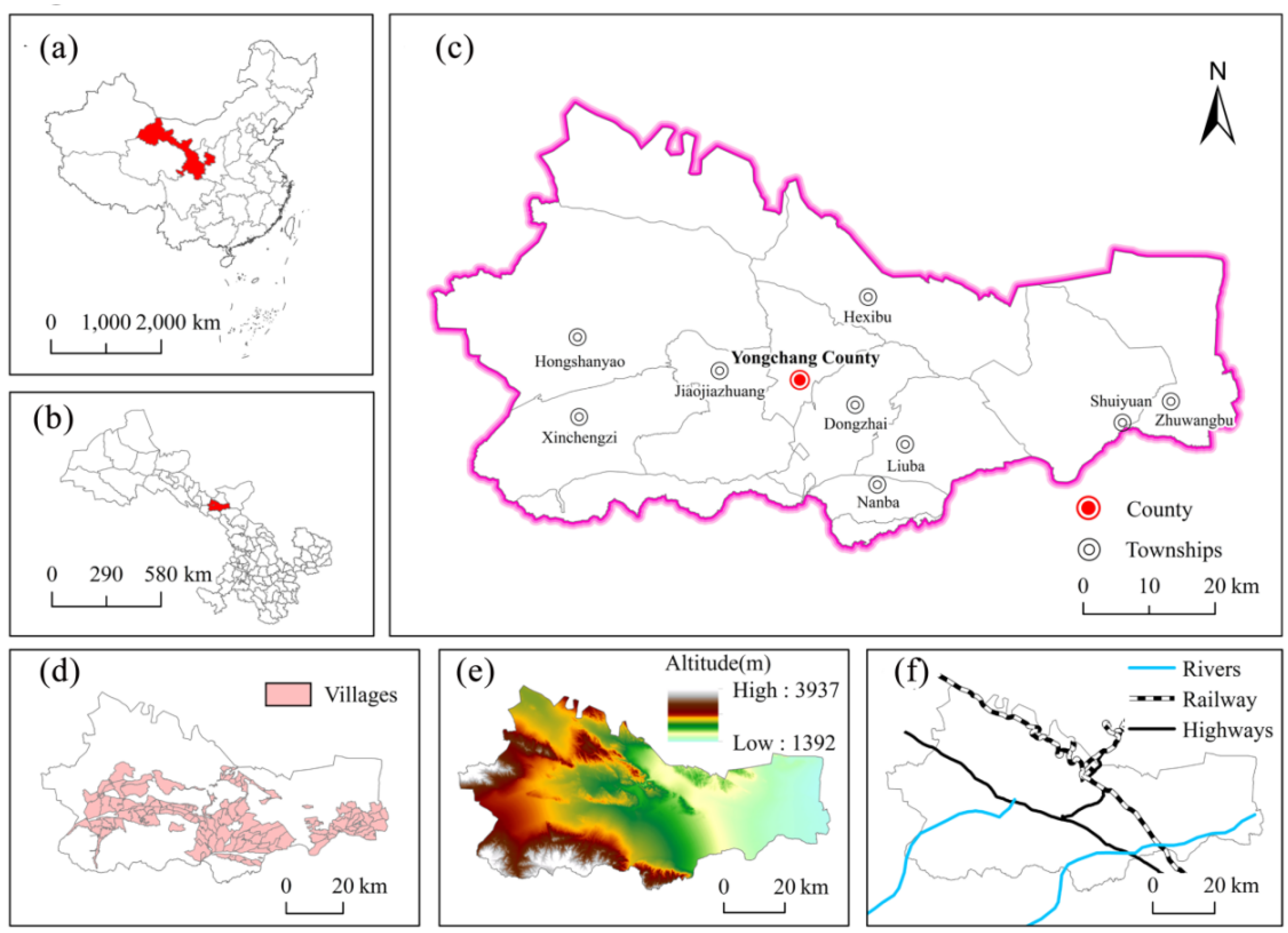
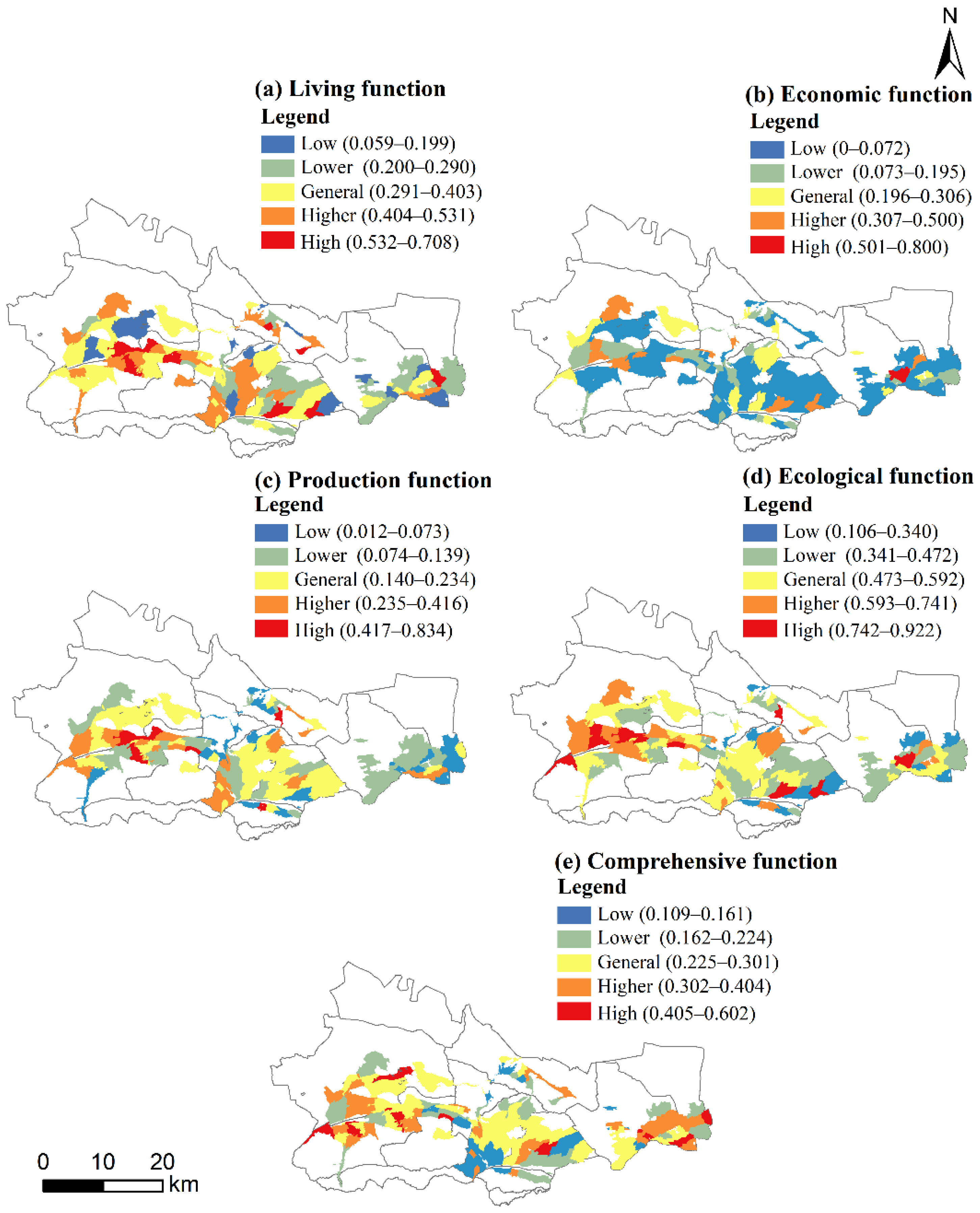

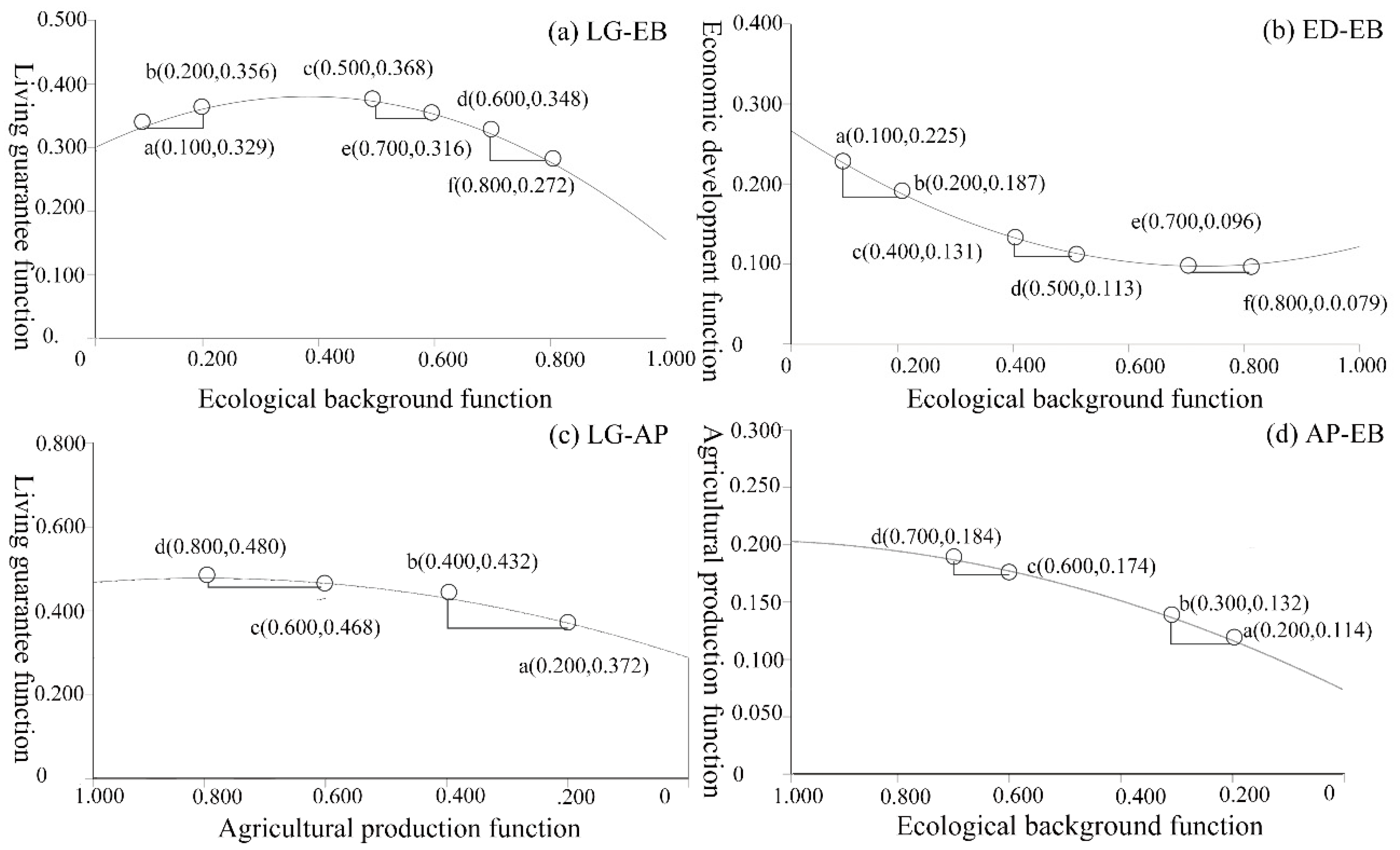
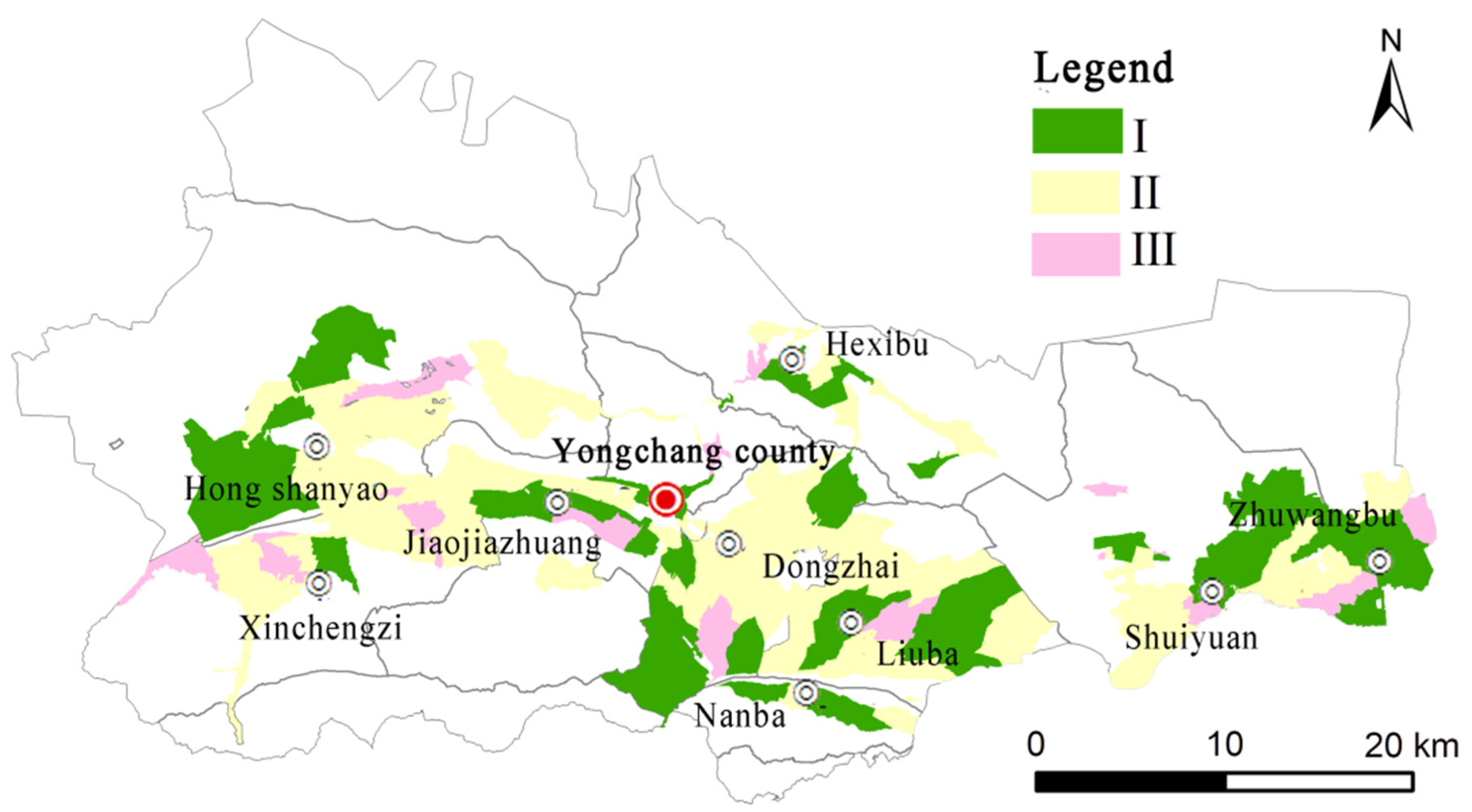
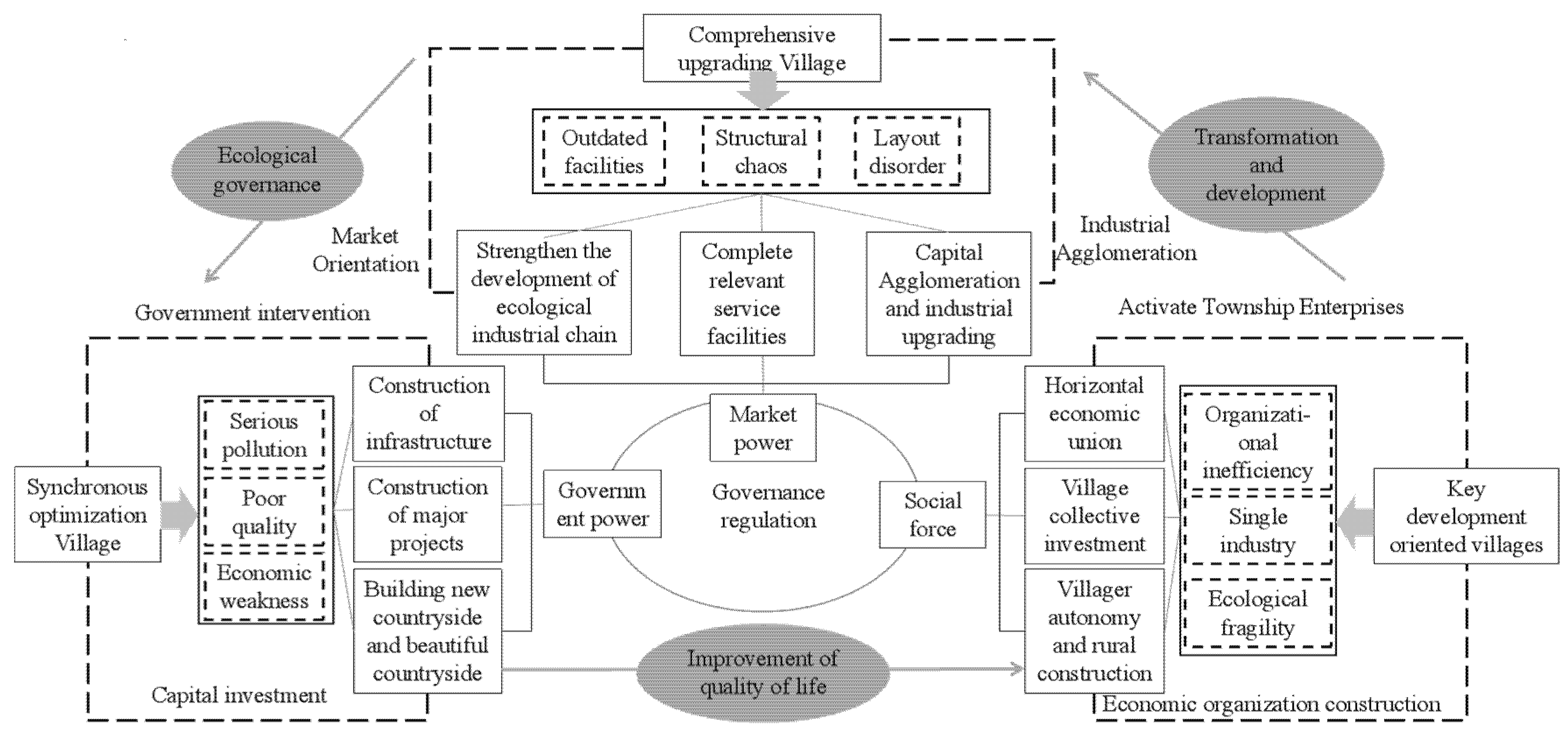
| Tier 1 Indicators | Secondary Indicators | Basic Indicators | Calculation of Indicators and Their Sources | Weights | Direction |
|---|---|---|---|---|---|
| Living guarantee (LG) | Public Services | Number of rural education facilities per 100 people X1 (schools) | Total number of kindergartens and elementary schools in the village area/resident population of the settlement ×100 | 0.1665 | + |
| Number of rural medical facilities per 100 people X2 (facilities) | Total number of health stations and health service stations in the village area/resident population of the settlement ×100 | 0.3746 | + | ||
| Occupancy of elderly care facilities per 100 people X3 (pcs) | Number of elderly care facilities/resident population of settlement×100 | 0.2134 | + | ||
| The number of rural cultural and sports facilities per 100 people X4 (one) | Number of sports and fitness venues and cultural stations/resident population of the settlement ×100 | 0.2455 | + | ||
| Infrastructure | Broadband coverage X5 (%) | The number of broadband resident groups/the number of village groups | 0.2192 | + | |
| Convenience of transportation X6 (%) | Number of village groups with road access/number of village groups in the village | 0.5986 | + | ||
| Tap water penetration rate X7 (%) | Number of households using piped water/number of households living in the village | 0.1822 | + | ||
| Living Environment | Average household homestead X8 (m/household2) | Area of residential land/number of permanent households in the village | 0.5978 | + | |
| Land area share of public service facilities X9 (%) | Land area of public service facilities/total land area of the village | 0.1681 | + | ||
| Percentage of infrastructure land area X10 (%) | Infrastructure land area/total land area of the village | 0.2341 | + | ||
| Economic development (ED) | Industry Integration | Agro-processing enterprises occupancy X11 (a) | Number of agricultural processing enterprises per 100 households | 0.3747 | + |
| Percentage of farm households conducting online sales of agricultural products X12 (%) | Number of agricultural products sold online in the village/number of households living in the village | 0.3936 | + | ||
| Percentage of farm households with business licenses and conducting leisure agriculture and rural tourism X13 (%) | The number of households with business licenses in the village that carry out leisure agriculture and rural tourism/the number of households living in the village | 0.2317 | + | ||
| Income level | Per capita disposable income of rural residents X14 (yuan) | Total income after deduction of income tax payable and various social security expenses paid by individuals | 0.048 | + | |
| Village collective operating income X15 (million yuan) | Village collective income from various production services and other business activities | 0.952 | + | ||
| Agricultural production (AP) | Factor input | Arable land per capita X16 (hm/person2) | Arable land area/total population of the village | 0.1811 | + |
| Proportion of land area for agricultural water conservancy facilities X17 (%) | Land area of pits, reservoirs, etc. used for irrigation in the village/total land area | 0.7042 | + | ||
| Area share of facility agriculture X18 (%) | Area of facility agriculture/area of cultivated land | 0.1147 | + | ||
| Scale of operation | Number of family farms per 100 people X19 (pcs) | Number of family farms/resident population of settlement×100 | 0.6112 | + | |
| Professional farmers’ cooperatives per 100 people X20 (pcs) | Farmer’s cooperative/resident population of settlement×100 | 0.3888 | + | ||
| Ecological background (EB) | Resource Conditions | Biological Abundance Index X21 | The frequency of distribution of the number of biological species in a certain spatial range is used to measure | 0.6456 | + |
| Normalized vegetation index X22 | Reflecting the relationship between plant biomass, leaf area index and vegetation cover | 0.3544 | - | ||
| topographic conditions | Terrain undulation X23 | The difference between the elevation of the highest point and the elevation of the lowest point in a given area | 1.000 | + |
| Countryside Function | Living Guarantee | Economic Development | Agricultural Production | Ecological Background |
|---|---|---|---|---|
| Living guarantee | 1.000 | 0.072 | 0.262 ** | −0.245 ** |
| Economic development | - | 1.000 | 0.053 | −0.203 * |
| Agricultural production | - | - | 1.000 | 0.197 * |
| Ecological background | - | - | - | 1.000 |
| Type Zone | Trade-Off Portfolio | Meaning |
|---|---|---|
| I | 11,12 | The trade-off among the living guarantee/economic development function and the ecological background function is weak. In the future, these three functions can be developed symbiotically to achieve the optimal benefits of rural multifunctionality. |
| II | 23,22 | The trade-off among the combination of living guarantee/economic development functions and ecological background functions is more drastic, allowing at most two of the functions to co-exist. |
| III | 33 | The intensity of the trade-off among regional living guarantee, economic development functions and ecological environment is drastic and in high conflict; at most one function can be developed under the existing living standards. |
| Partition Type | Public Services | Infrastructure | Living Environment | |||
| Barrier Mean | Impact Rate | Barrier Mean | Impact Rate | Barrier Mean | Impact Rate | |
| I | 24.38 | 53.85 | 1.33 | 46.15 | 26.22 | 84.62 |
| II | 22.62 | 63.64 | 0.78 | 52.27 | 26.53 | 65.91 |
| III | 24.44 | 69.09 | 0.76 | 72.73 | 26.93 | 60 |
| Partition Type | Income level | Industry Integration | Factor input | |||
| Barrier mean | Impact rate | Barrier mean | Impact rate | Barrier mean | Impact rate | |
| I | 12.2 | 76.92 | 5.93 | 53.85 | 15.65 | 69.23 |
| II | 11.61 | 81.82 | 6.67 | 70.45 | 16.29 | 59.09 |
| III | 12.06 | 69.09 | 6.32 | 70.91 | 15.4 | 54.55 |
| Partition Type | Scale of operation | Resource Conditions | Topographic conditions | |||
| Barrier mean | Impact rate | Barrier mean | Impact rate | Barrier mean | Impact rate | |
| I | 10.27 | 76.92 | 1.02 | 38.46 | 3 | 69.23 |
| II | 10.88 | 65.91 | 1.38 | 52.27 | 3.24 | 65.91 |
| III | 9.99 | 72.73 | 1.07 | 54.55 | 3.03 | 60 |
Publisher’s Note: MDPI stays neutral with regard to jurisdictional claims in published maps and institutional affiliations. |
© 2022 by the authors. Licensee MDPI, Basel, Switzerland. This article is an open access article distributed under the terms and conditions of the Creative Commons Attribution (CC BY) license (https://creativecommons.org/licenses/by/4.0/).
Share and Cite
Ma, L.; Li, Y.; Cui, X.; Tao, T. Land Management and Rural Development in Northwest China. Land 2022, 11, 1423. https://doi.org/10.3390/land11091423
Ma L, Li Y, Cui X, Tao T. Land Management and Rural Development in Northwest China. Land. 2022; 11(9):1423. https://doi.org/10.3390/land11091423
Chicago/Turabian StyleMa, Libang, Yawei Li, Xijuan Cui, and Tianmin Tao. 2022. "Land Management and Rural Development in Northwest China" Land 11, no. 9: 1423. https://doi.org/10.3390/land11091423
APA StyleMa, L., Li, Y., Cui, X., & Tao, T. (2022). Land Management and Rural Development in Northwest China. Land, 11(9), 1423. https://doi.org/10.3390/land11091423








